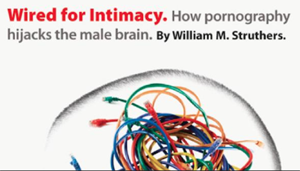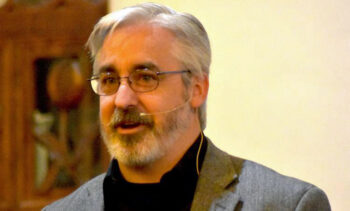By Mark Ellis –
The science of the brain is revealing unsettling facts about the way pornography can rewire the circuitry of the brain, deeply embedding addictive pathways that invariably lead viewers to act out behaviors they might never have considered.
“When you look at pornography it’s changing everything,” Dr. William Struthers Ph.D. told Pure Passion Media’s (PPM) David Kyle Foster. “It’s changing the way that you look at women. It’s changing the way that you look at men. It’s changing the way that you think about yourself.”
Dr. Struthers is a professor of psychology at Wheaton College and the author of Wired for Intimacy: How Pornography Hijacks the Male Brain.

The brain is a beautiful instrument with delicate circuits being modified by signals it receives. “The brain is one of the few organs that modifies itself. Pornography is coming in and it’s exploiting these sensitive circuits in the brain in men and also in women,” he notes.
In the past, people didn’t go through life seeing thousands of different people having sex in front of them all the time. “When you’re viewing hundreds of different men and hundreds of different women and hundreds of different sexual acts with the click of a mouse, that is not what the brain is expecting. Historically that is not what the brain is designed to expect,” he told PPM.
“We’ve reached a point in time now because of technology that the brain is being raped by pornography. It really is a rape of the mind.”

Dr. Struthers compares pornography to the secondhand smoke of our culture. People can try to get away from it, endure the annoyance, or join in and become a smoker.
When one is aroused by porn, adrenaline is released in the body, along with the brain’s version of adrenaline called norepinephrine. “Norepinephrine is the neurotransmitter that helps you helps you get up in the morning, helps you form long lasting memories,” he noted.
Another neurotransmitter released is dopamine, which helps people focus. “It’s the thing that kind of pulls you in…so you lose track of everything else. So a person who is viewing pornography will be drawn into it and they’ll forget everything else that’s going on around them. They’ll lose track of time.”
Dopamine is released in most addictive drugs, such as cocaine and amphetamine.
When the sexual need is met, a third neuropeptide is released, endogenous opiates called endorphins. When they are released the person feels euphoria and a release of all tension in the body.
Serotonin is also activated in people who view pornography, which affects people’s mood. “Many antidepressants like Prozac will work on serotonin as well.”
A perfect storm for addiction
“So you’ve got a bunch of different chemicals that are being released in the body but also in the brain that are forming this sort of perfect storm for you to remember, for you to focus, for you to have your mood modulated, and also for you to experience the release and relief from sexual tension when the person finally acts out,” he told PPM.
Two smaller hormones released, oxytocin and vasopressin serve to bind a person to whatever it was that met their need. “It’s God’s plan to be bound to one another and that’s a good thing, when these needs are being met appropriately by your husband or your wife,” Dr. Struthers observed.
With porn, an individual is bound to a representation of a person. “It’s difficult to get yourself sufficiently aroused with just pictures, so what will happen is the person will usually have to look at lots of different pictures.” As satisfaction becomes more difficult to attain, they engage in an exhaustive quest for novelty, ultimately becoming bound to a sequence of behaviors – a ritual.
Mirror neuron circuits – ‘Monkey see, monkey do’
Pornography activates a set of circuits in the brain called mirror neuron circuits, which work in such a way that the brain will mirror what it sees. “If I see someone engage in a specific behavior the circuits would be activated if I were to engage in that behavior… whatever they do I do.”
In the same way a child picks up their parents’ mannerisms, viewers of pornography pick up the mannerisms of the people who engage in the pornography.
“Pornography does not just bounce off of your eyes and doesn’t affect you long-term. It is priming you to do things that you might not have ever thought to do in the future because you’d never seen them before,” Dr. Struthers noted.
Unfortunately, pornography becomes a form of sex education.
The surge of hormones is like a flash flood carving pathways in the brain, a pathway that becomes easier to trod the next time. “You keep viewing the pornography and you keep sexually acting out in this way that serves to make the path deeper and well worn. That spiral of addiction will get deepened every time you pass down it.”
Hope for change
Dr. Struthers says it is possible to reverse the destructive cycle. “If you can find a healthy outlet that you begin to have as the alternative path that does not lead you to sin, that’s what you need to be thinking about.
If one can establish virtuous patterns of behavior, and repeat them over and over until they become habits, the circuit of depravity can become a circuit of virtue.
While the brain can be exploited, it is also an organ that can be exercised in a virtuous way to arrive at a place of significant victory over sin.
People often fall into the trap of porn addiction because of a desire for intimacy, but they end up with a false form of meeting that need. “We have to work with the history of that brain and how it got to that place,” he said.
Dr. Struthers recommends prayer, reading Scripture, listening to worship music — and avoiding pornography. “Let the moss grow over that path, let that circuit become less efficient by not activating it regularly, and replace it with something else.”
“A real major factor is whether the person really does want to change. You’re going to go through withdrawal and you just have to understand that and accept that. There will be a detox period where you’re going to feel that need very powerfully.
“Most addiction researchers will tell you that the person’s desire to quit and the social support they have is going to be crucial. The body of Christ has to come around the person.”
Hiding in the shadows due to shame doesn’t help. “This needs to be brought to the light and other people need to come around them if they are to really have any significant chance. There may be some people God may come in in a supernatural way and deliver them instantaneously but I would say that’s not the way that God usually works.”
“We need each other in this process.”
 To learn more about Pure Passion Media, go here
To learn more about Pure Passion Media, go here




Very important article. More needs to be done to explore the options for Christian men to get help and break from porn. It is not enough to explore the dangers. This article is important because it explores the neuro-physiology of addiction. Pure Passion has support groups for such men, and there are others. But it seems to me that we need more talk, not just about the dangers, but the methods of escape from the clutches of addiction. How about an article on Kirk Franklin, who came clean a few years ago about his porn habits, which were born of a broken childhood?
The emphasis on neuro-chemical explanations, brain wiring and socio-cultural causes seems to be the scientific rational way to explain and indeed overcome “bad” addictions. However the article does not consider that “addiction” per se may be a fact of life and survival. It does not go to the root cause of these addictions, which I believe is the societal breakdown of families due to their inability to cope either mentally, spiritually or even financially, with a rapidly changing environment caused by disruptive technologies, politics and globalization. This is resulting in some form of a communal collapse of the large parts of mainstream Western societies, akin to the destruction of indigenous tribes worldwide. In my view, much of the bad addictions are nothing more than coping mechanisms of people facing alienation in an increasingly dysfunctional society.
Comments are closed.